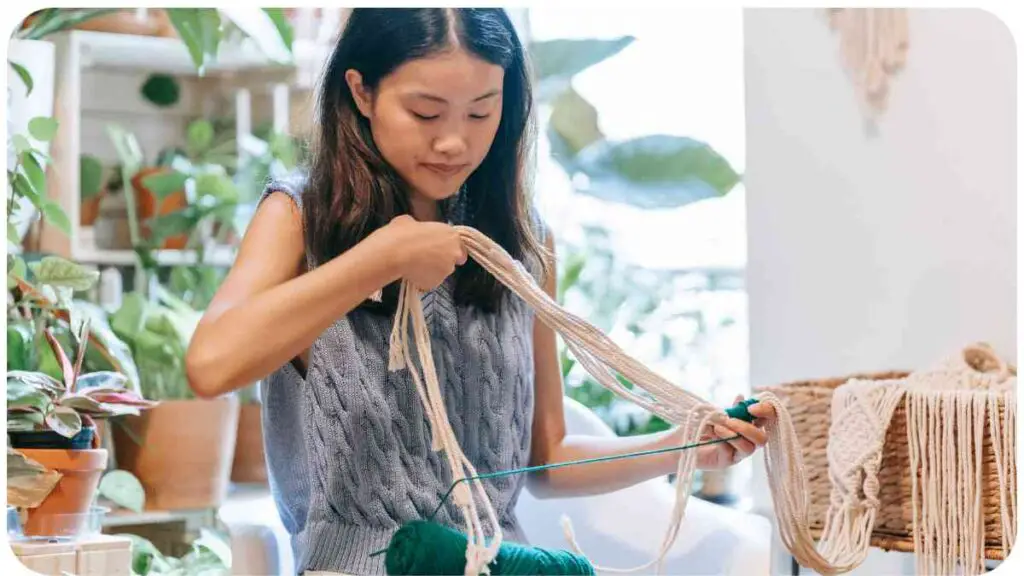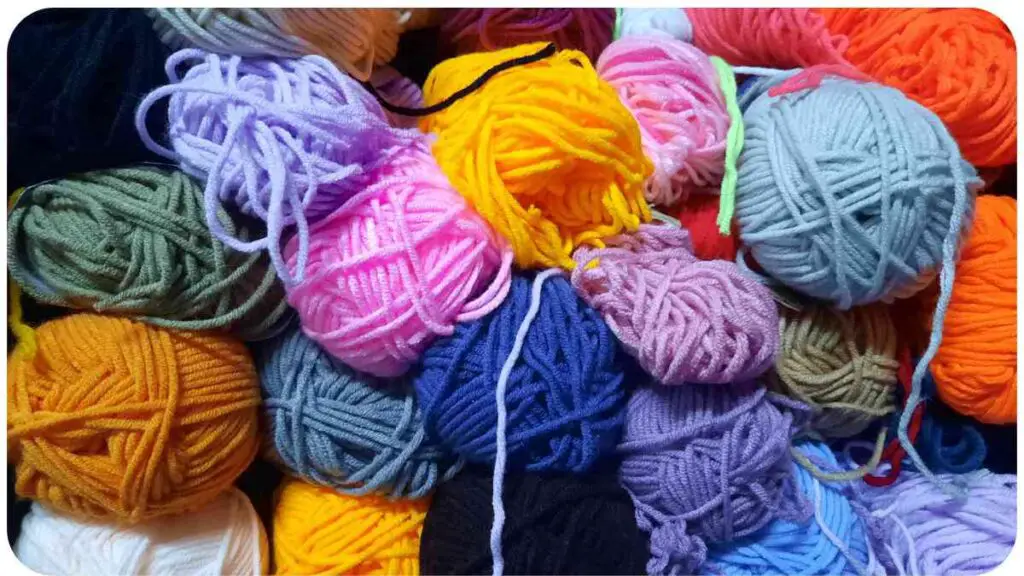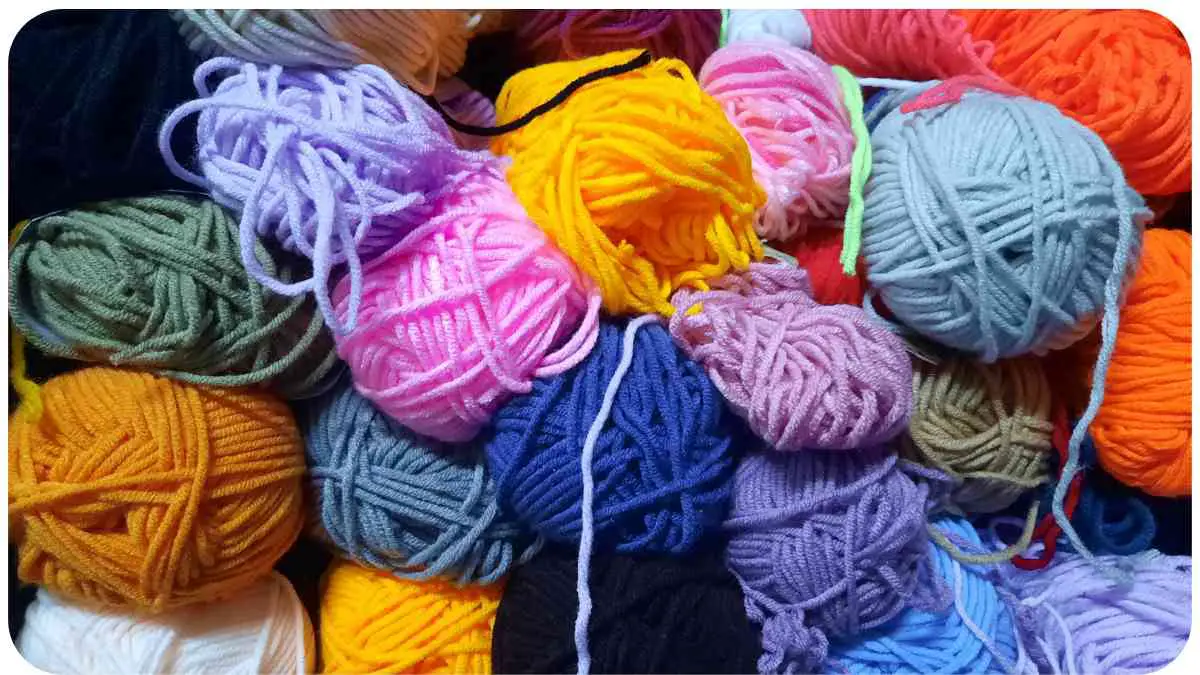Welcome to this comprehensive guide on crocheting with knitting yarn! If you’re a crochet enthusiast who’s curious about using knitting yarn for your projects, you’ve come to the right place.
In this article, we’ll explore the compatibility of crocheting and knitting yarns, discuss the considerations for choosing the right yarn, and delve into various techniques and projects. So, let’s unravel the mysteries together and discover the exciting possibilities of crocheting with knitting yarn!
| Takeaways |
| Knitting and crochet are two distinct crafts that use different techniques and tools. |
| Yarn used in knitting and crochet can vary in weight, fiber content, and texture. |
| Choosing the right yarn for your project is important, considering factors like fiber content, thickness, and desired aesthetic. |
| When substituting knitting yarn for crochet, adjust hook size and consider the texture and yardage requirements. |
| Crocheting with knitting yarn offers unique possibilities and allows for experimentation with various techniques. |
| Advanced crochet techniques like filet crochet, crocheted lace, and colorwork can be explored with knitting yarn. |
| Projects that can be made with knitting yarn in crochet include scarves, blankets, fashion accessories, and home decor items. |
| FAQs address common questions about using knitting yarn for crochet and offer tips for overcoming challenges. |
2. Understanding the Difference between Crocheting and Knitting
Before we dive into the world of crocheting with knitting yarn, it’s essential to understand the fundamental differences between crocheting and knitting. While both crafts involve creating beautiful items with yarn, the techniques and tools used vary significantly.
Knitting involves working with two or more needles, creating a fabric using interlocking loops. On the other hand, crocheting utilizes a single hook to create stitches that form a fabric. The stitch structure and texture differ between the two, giving each craft its unique characteristics.
3. Exploring the Compatibility of Crocheting and Knitting Yarns

One common question that arises is whether knitting yarn can be used for crocheting projects. The answer is a resounding “yes!” While crocheting and knitting yarns are designed for specific crafts, they are often interchangeable, allowing you to explore a wide range of yarn options for your crochet projects. However, there are a few considerations to keep in mind to ensure optimal results.
The primary factor to consider is the weight, or thickness, of the yarn. Using the appropriate weight ensures that your finished product matches the desired dimensions and provides the expected drape and stitch definition. Additionally, considering the fiber content is crucial, as different fibers may affect the characteristics of your crochet project, such as its texture, drape, and care instructions. Always check the yarn label for information on weight, fiber content, and recommended needle or hook sizes.
“When considering your yarn options for crochet, it’s important to know the differences between crochet and knitting yarn. Understanding these distinctions can help you create the perfect project.”
4. Choosing the Right Yarn for Your Crochet Projects
When it comes to selecting yarn for crochet, there are various factors to consider. These factors include the yarn weight, fiber content, color selection, and brand reputation.
4.1 Understanding Yarn Weight and Fiber Content
Yarn weight refers to the thickness of the yarn strand, which affects the size and appearance of the final project. The most common yarn weights include lace, fingering, sport, DK, worsted, bulky, and super bulky. Each weight has its own set of recommended needle or hook sizes, allowing you to create items with different stitch densities. When crocheting with knitting yarn, it’s crucial to match the recommended hook size to achieve the desired results.
Fiber content is another crucial aspect when selecting yarn for your crochet projects. Common fibers include wool, acrylic, cotton, alpaca, silk, and blends. Each fiber has its unique properties, such as warmth, durability, softness, and stretchiness.
Consider the characteristics you desire in your finished project and choose a yarn accordingly. For example, if you’re making a warm winter scarf, using a wool or alpaca blend yarn would be a great choice for its insulation properties.
4.2 Factors to Consider When Choosing Yarn for Crocheting

In addition to yarn weight and fiber content, there are a few other factors to consider when selecting the perfect yarn for your crochet projects. These factors include:
- Texture: The texture of the yarn affects the look and feel of your finished project. Some yarns have a smooth texture, perfect for achieving clean stitch definition, while others have a more textured appearance, adding depth and interest to your crochet work.
- Color: The color of the yarn is an important consideration, as it can significantly impact the overall aesthetic of your project. Whether you prefer bold, vibrant colors or subtle, muted tones, choose a color palette that aligns with your vision and complements the intended purpose of the item.
- Quantity: Determine the amount of yarn needed for your project before making a purchase. The pattern or design you’re following will usually specify the yardage or weight required. Having the right amount of yarn ensures you can complete your project without running out.
“If you’ve ever wondered about using knitting patterns for crochet projects, this guide on understanding the differences between the two techniques will provide you with valuable insights and tips.”
4.3 Popular Yarn Brands for Crochet
When it comes to choosing a reliable yarn brand, there are several reputable options available. Here’s a comparison of some popular yarn brands based on factors like variety, quality, and affordability:
Table 1: Comparison of Popular Yarn Brands
| Brand | Variety of Yarns | Quality | Affordability |
| Brand A | High | Excellent | Moderate |
| Brand B | Medium | Good | Affordable |
| Brand C | Low | Average | Budget-friendly |
| Brand D | High | Excellent | Splurge |
Please note that this table is not exhaustive and serves as a starting point for your yarn brand research. Each brand offers a unique selection of yarns, encompassing different weights, fiber contents, and colors. Consider exploring various options to find the perfect fit for your crochet projects.
4.4 Tips for Substituting Knitting Yarn for Crochet
Sometimes you may find a beautiful knitting yarn that you wish to use for your crochet project. While substituting knitting yarn for crochet is possible, there are a few things to keep in mind:
- Gauge: Check the recommended gauge in the knitting pattern or yarn label. Crochet stitches tend to use more yarn than knitting stitches, so you may need to adjust your hook size to achieve the correct gauge.
- Yardage: Knitting patterns often specify yarn amounts based on skeins. However, crochet projects typically require more yarn compared to knitting. Ensure you have enough yarn to complete your project by estimating the total yardage needed based on the pattern.
- Texture: Consider the texture of the knitting yarn and how it may affect the appearance of your crochet project. Knitting yarns that have a high twist may not provide the same drape or stitch definition as traditional crochet yarns. Adjusting your stitch pattern or experimenting with different hooks may be necessary.
4.5 Common Challenges and Solutions
Crocheting with knitting yarn can present a few challenges, but with some troubleshooting, you can overcome them. Here are some common obstacles and their solutions:
- Tension Issues: Knitting yarns may require different tension due to their thickness or fiber content. Adjust your crochet tension by experimenting with different hook sizes or adjusting your hand grip to achieve even, consistent stitches.
- Yarn Splitting: Some knitting yarns have loosely spun plies, making them prone to splitting while crocheting. Take care when inserting the hook to avoid splitting the yarn, or consider using a smaller hook size to minimize splitting.
- Incompatibility of Stitches: Certain crochet stitches may not look as defined or have the same appearance when worked with knitting yarn. Experiment with different stitch patterns to find ones that showcase the beauty of the yarn and create the desired effect.
- Yardage Calculation: As mentioned earlier, crochet projects tend to require more yarn than their knitting counterparts. Calculate your yardage requirements, keeping in mind factors such as stitch density, stitch pattern, and intended project size, to ensure you have enough yarn to complete your project.
By understanding these challenges and their solutions, you can confidently embark on your crocheting journey with knitting yarn and embrace the unique possibilities they offer.
Now that we’ve covered the considerations and challenges of using knitting yarn for crochet, let’s explore different crocheting techniques with knitting yarn in the next section.
5. Crocheting Techniques with Knitting Yarn
Whether you’re aiming to create a delicate lace shawl or a cozy blanket crocheting with knitting yarn opens up a world of possibilities. Here are some techniques you can experiment with to achieve stunning results:
“Selecting the right yarn for your crochet project is crucial. Check out our comprehensive guide on how to choose the right yarn to ensure your crochet creations turn out beautifully.”
5.1 Basics of Crocheting with Knitting Yarn
To begin crocheting with knitting yarn, start by selecting a suitable hook size based on the yarn weight. Refer to the yarn label or pattern instructions for guidance. Once you have your materials ready, follow these basic steps:
- Make a slip knot and slide it onto your crochet hook.
- Insert the hook into the designated stitch or space.
- Yarn over (wrap the yarn around the hook from back to front).
- Pull the yarn through the stitch or space, creating a loop on the hook.
- Yarn over again and pull the yarn through the two loops on the hook, completing the stitch.
Practice basic stitches like single crochet, double crochet, and treble crochet with knitting yarn to get comfortable with the technique.
5.2 Adjusting Crochet Stitches for Knitting Yarn
Crochet stitches may need to be adjusted when using knitting yarn to achieve the desired result. Here are some adjustments you can make:
- Hook Size: Experiment with different hook sizes to achieve the desired fabric texture and tension. Larger hooks create looser stitches, while smaller hooks create tighter stitches.
- Stitch Height: Certain knitting yarns may result in taller or shorter stitches compared to traditional crochet yarns. To maintain proportion, adjust the number of stitches or rows in your project accordingly.
- Stitch Density: If you find that your crochet fabric is too dense or stiff, try using a larger hook to create more open and airy stitches. Conversely, if your fabric lacks structure, using a smaller hook can provide better stitch definition.
Remember, crocheting with knitting yarn is an opportunity for experimentation and creativity. Don’t be afraid to try different techniques and adjust as needed to achieve the results you envision.
“Don’t let knitting mistakes discourage you. Our step-by-step guide will help you tackle common issues with confidence, ensuring your knitting and crochet projects come out flawlessly.”
5.3 Advanced Crochet Techniques with Knitting Yarn
Once you’ve mastered the basics of crocheting with knitting yarn, you can explore advanced techniques to elevate your projects. Here are a few techniques to consider:
- Filet Crochet: Filet crochet is a versatile technique that incorporates openwork and solid blocks to create intricate and visually appealing designs. It can be especially stunning when executed with contrasting colors of knitting yarn.
- Crocheted Lace: Knitting yarn lends itself well to creating delicate and intricate lace patterns. Experiment with lace stitches like shells, clusters, and picots to add elegance and daintiness to your crochet projects.
- Colorwork: Knitting yarn often comes in a vast array of beautiful colors, making it ideal for creating colorwork designs in crochet. Explore techniques such as tapestry crochet or intarsia to incorporate multiple colors and intricate patterns into your projects.
- Surface Crochet: Surface crochet involves working stitches or embellishments on the surface of a completed crochet fabric. Use knitting yarn to add decorative borders, appliques, or embroidery-like details to your projects.
By incorporating these advanced techniques into your crocheting repertoire, you’ll be able to create unique and eye-catching pieces that showcase your skills and creativity.
In the next section, let’s explore some examples of crochet projects that can be made using knitting yarn.
6. Examples of Crochet Projects Using Knitting Yarns
Crocheting with knitting yarn opens up a whole new world of possibilities for creating various projects. Here are some examples of projects that can be made using knitting yarn:
- Cozy Scarves: Knitting yarn, especially those with a soft and warm fiber content, is perfect for crocheting cozy scarves. Experiment with different stitch patterns and color combinations to create a one-of-a-kind accessory.
- Blankets and Throws: Whether you prefer a lightweight baby blanket or a chunky, warm throw, knitting yarn can be used to create stunning crochet blankets. Choose a yarn with the desired thickness and softness to ensure maximum comfort.
- Fashion Accessories: From hats and headbands to fingerless gloves and shawls, knitting yarn offers a wide range of possibilities for crocheted fashion accessories. Play with texture, color, and stitch patterns to add your personal style to these accessories.
- Home Decor Items: Crocheted home decor items such as pillows, wall hangings, and table runners can be beautifully crafted using knitting yarn. Explore different patterns and color combinations to create pieces that complement your interior aesthetics.
Remember, these examples are just the tip of the iceberg. Let your creativity soar and use knitting yarn to crochet unique items that reflect your personal style and preferences.
Now, let’s address some frequently asked questions regarding crocheting with knitting yarn in the upcoming section.
FAQs
Q: Can I use knitting yarn for crochet projects?
A: Yes, knitting yarn can be used for crochet projects. However, it may require adjustments in tension, hook size, and stitch patterns to achieve the desired result.
Q: Will crocheting with knitting yarn affect the final appearance of my project?
A: Crocheting with knitting yarn may have an impact on the drape, texture, and stitch definition of your project. It’s important to consider the characteristics of the yarn and make any necessary adjustments to achieve the desired appearance.
Q: How much knitting yarn should I purchase for a crochet project?
A: The amount of yarn needed for a crochet project may differ from knitting patterns. It’s best to calculate the estimated yardage based on the stitch pattern, project size, and desired results. Refer to the pattern or consult a yarn calculator for a more accurate estimation.
Q: Are there any specific crochet techniques that work well with knitting yarn?
A: Techniques such as filet crochet, crocheted lace, colorwork, and surface crochet can beautifully showcase the characteristics of knitting yarn. Experiment with different techniques to create unique and intricate designs.
Q: What are some common challenges when using knitting yarn for crochet?
A: Tension issues, yarn splitting, incompatibility of stitches, and yardage calculation can be common challenges when crocheting with knitting yarn. By adjusting tension, using smaller hooks to minimize splitting, experimenting with stitch patterns, and estimating yardage accurately, many of these challenges can be overcome.

My name is Hellen James, and I’m a crochet and knitting expert. I’ve been crocheting since I was just a kid, but I started taking it seriously when I realized that it was a great way to de-stress and relax. Now that I have kids of my own, I love teaching them how to do it too!

